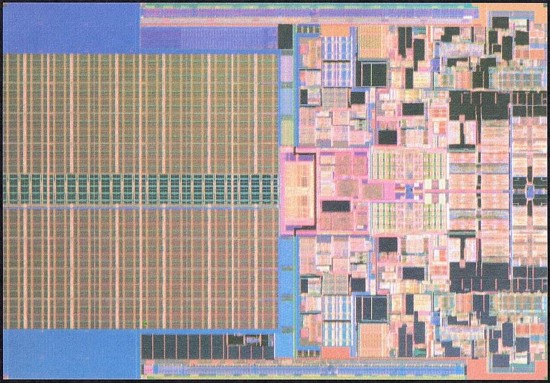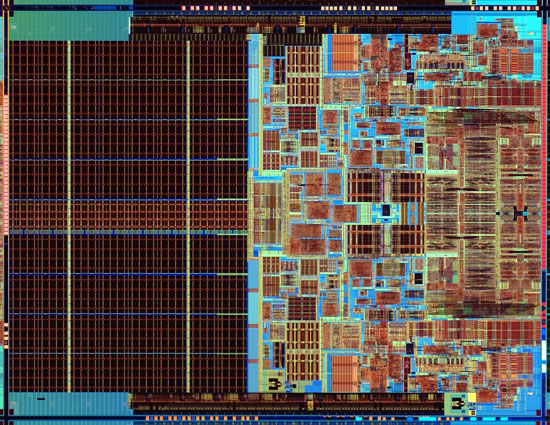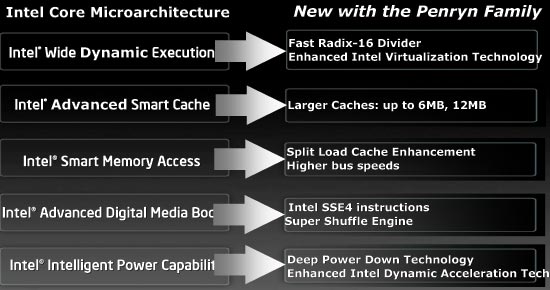The Penryn Preview - Part I: Wolfdale Performance
by Anand Lal Shimpi on August 21, 2007 12:35 PM EST- Posted in
- CPUs
By the end of this year, AMD will introduce Phenom and Intel will introduce Penryn - its first 45nm desktop CPU.
For a while there we wondered how Intel would introduce Penryn into its lineup, but as of Intel's last roadmap update we now know. On top of that, we managed to get our hands on a dual-core Penryn so now we know exactly how fast the new core is going to be. Combine the two datapoints and there's a wealth of knowledge to share. So gather 'round the fire, it's time to benchmark CPUs.
Recapping Penryn
Penryn is more than just a die-shrunk Conroe, but it isn't anywhere near as revolutionary as what Conroe was to its predecessor. The Conroe-Penryn evolution is one cycle of Intel's tick-tock model, Penryn's successor (Nehalem) will be the next revolutionary core you see out of Intel (at least that's what we're expecting).

Penryn is built on Intel's 45nm process, thus dropping power consumption increasing switching speed and allowing Intel to cram more transistors on a die (107mm^2 for dual-core Penryn vs. 143mm^2 for Conroe).

A dual-core Penryn die

A dual-core Conroe die
Intel lists the following 9 enhancements as what's new in the Penryn family:

The faster divider and super shuffle engine will increase performance in very specific applications and won't be broad increasers of performance. The larger caches obviously will increase performance, but prior to today we weren't sure by how much.
SSE4 support can bring about tremendous performance improvements, but it requires software optimization. In our initial Penryn Preview we reported an over 100% increase in performance in SSE4 optimized DivX encoding for a quad-core Penryn at 3.33GHz vs. a quad-core Kentsfield at 2.93GHz.
We detailed all of the Penryn enhancements and the markets they impact in our original Penryn article. Keep in mind that things like Penryn's Deep Power Down Technology and higher bus speeds may not apply to all Penryn cores (the former is only in Mobile Penryn while the latter will appear on servers first).
Never Take Sides Against the Family
Penryn is the overall family name but there are two cores in particular that we'll be talking about today: Wolfdale and Yorkfield.
Wolfdale is a dual-core desktop Penryn core with a 6MB L2 cache shared between the two cores. Yorkfield is two Wolfdales on the same package, giving the quad-core CPU a total of 12MB of L2 cache.
Wolfdale and Yorkfield are architecturally identical, so performance per core is no different between the processors - Yorkfield simply has more cores.










55 Comments
View All Comments
zsdersw - Tuesday, August 21, 2007 - link
The idiots who predicted a "huge improvement" existed only in your mind, I suspect.. or were never a group of any nominal size to begin with.sprockkets - Wednesday, August 22, 2007 - link
Not really. Search even this site and find stories like "30% improvement over Conroe." They painted Penryn as if it was such a major advance in technology that it would obliterate anything or anyone period had on the planet.sprockkets - Wednesday, August 22, 2007 - link
Yeah, here:http://www.dailytech.com/Intel+Unveils+Penryn+Perf...">Daily Tech Penryn "Benchmarks"
Funny How Intel benchmarked the processors and got "amazing" benefits over the previous generation. Of course they didn't do a clock for clock comparision.
coldpower27 - Thursday, August 23, 2007 - link
Most people were claiming was 5-10% improvement per clock over Conroe, and that is what the data from Anandtech and HKEPC shows, if your talking overall improvements that is trickier as it would depend on what the clockspeed as well, so up to 30%, is not impossible given the right circumstances and depending on what Yorkfield XE tops out at.Performance is not derived from just a clock per clock comparison, you also have to take into account overall clockspeed increases, cache, FSB. Don't expect any corporation to put their processors in any sort of unflattering light, it is in their best interest to make themselves look good, not bad.
zsdersw - Thursday, August 23, 2007 - link
Nowhere in the comments of that story did anyone make any wild performance claims.sprockkets - Friday, August 24, 2007 - link
No, I don't see any inflation here at all.
And if AMD can make a processor run at 3ghz on 90nm, uh, yeah, kinda expect a processor 2 generations down the process line to be able to reach 3.3ghz without issues.
zsdersw - Wednesday, August 22, 2007 - link
Again, not a group of people big enough to be significant.dualathlon - Tuesday, August 21, 2007 - link
Would you please include some wu benchmarks from FAH ?Thanks.
Rebel44 - Tuesday, August 21, 2007 - link
I would also like to see some F@H benchmarks.conquerist - Tuesday, August 21, 2007 - link
1) What HSF was used for the OC? The stock HSF or the Thermalright Ultra 120 Extreme?2) As mentioned before, how does it OC at a higher Vcore?
3) Could you use x264 for the multimedia tests? I suggest this because x264 is open source, and so you can use Intel Compiler 10 or GCC 4.3 with the msse4.1 switch to compile it in SSE4.1! It would be interesting to see how Conrow vs. Penryn SSE3 vs. Penryn SSE4 compare. You can grab a daily tarball of the source at ftp://ftp.videolan.org/pub/videolan/x264/snapshots...">ftp://ftp.videolan.org/pub/videolan/x264/snapshots....